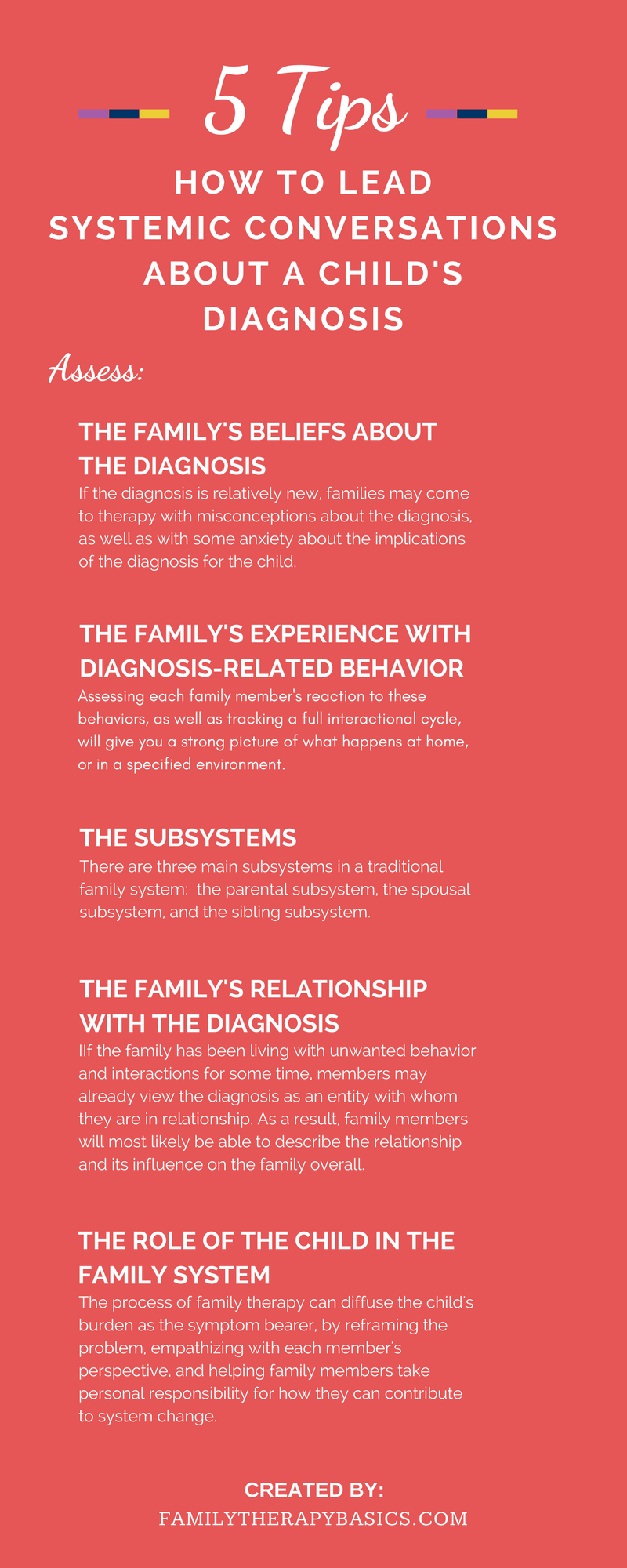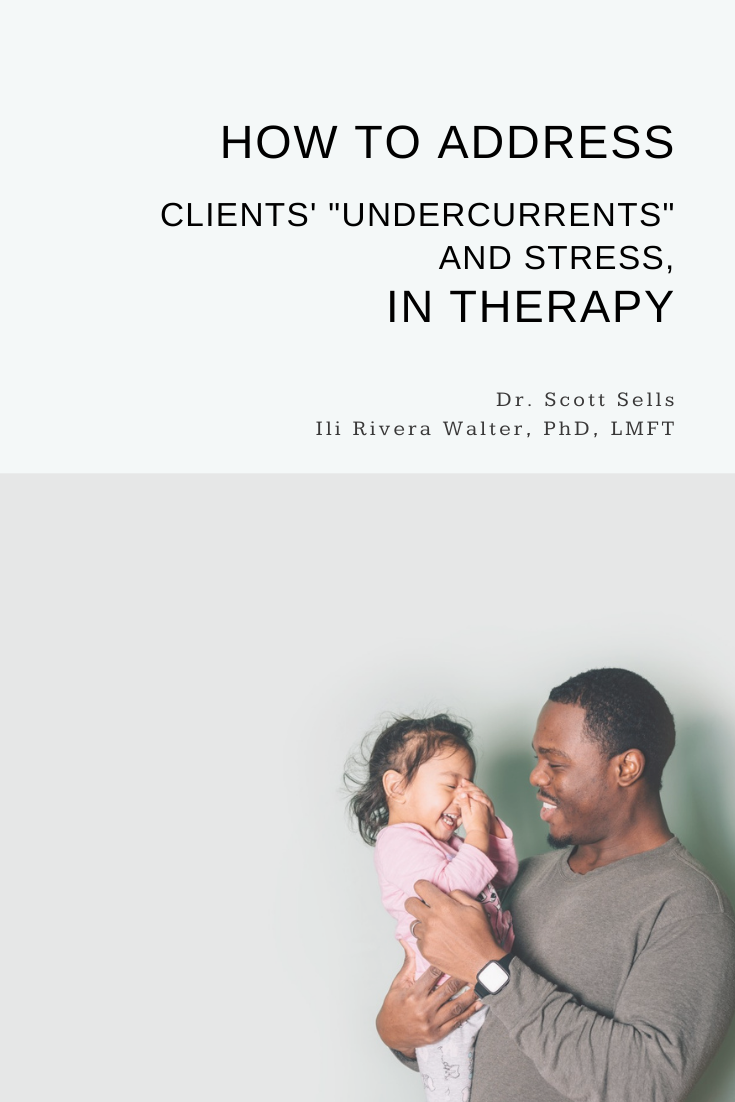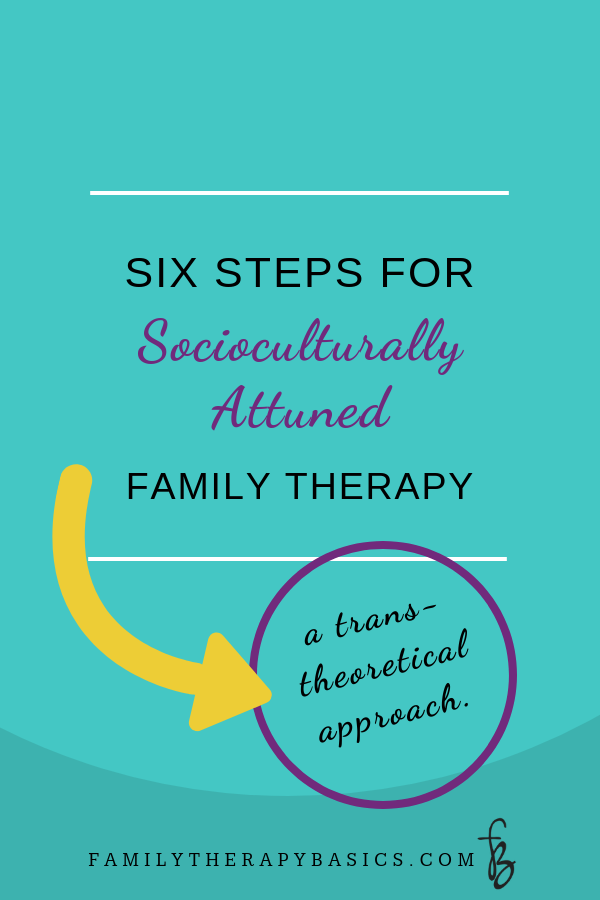Therapy involving children will often lead to conversations with parents about a child's diagnosis, or potential diagnosis. Whether or not you diagnose regularly, failing to assess and discuss a diagnosis as well as its impact on the family system means ignoring a significant element in the family's day-to-day interactions. Additionally, bringing diagnosis conversations into family therapy allows all family members to voice the influence of the diagnosis on his/her perceptions of the behavior and the diagnosed child.
The following questions provide ideas for how to have conversations with families about the presence of a diagnosis in the family system, from a variety of systemic orientations.
1 | The Family's Beliefs about the Diagnosis
Talking with families about diagnosis involves discussing, with them, their beliefs about the diagnosis. If the diagnosis is relatively new, families may come to therapy with misconceptions about the diagnosis, as well as with some anxiety about the implications of the diagnosis for the child. Some questions for assessing the family's beliefs include:
What do you know about X (the diagnosis)?
What does X mean for you? (to the child with the diagnosis, as well as each member of the family)
What are your concerns about X?
In each question, I've italicized the intention for the question--either knowledge, individual meaning-making, or anxiety/worry. If the individual provides additional information, but doesn't specifically target these three areas in his/her answer, ask follow-up questions with these targets in mind.
2| The Family's Experience with Diagnosis-Related Behavior
For every child with a diagnosis, there is a unique set of symptoms and behaviors that occur for the child that are either exacerbated or calmed during specific familial interactions. Understanding the family's dynamic around these behaviors takes time; however, assessing each family member's reaction to these behaviors, as well as tracking a full interactional cycle, will give you a strong picture of what happens at home, or in a specified environment.
Assess each family member's reaction to behaviors;
Ask the diagnosed child how a specific behavior, or the diagnosis in general, impacts him/her.
Involve the family members in validating and summarizing the child's experience.
Follow up by asking every member of the family, in the child's presence, how interactions around the behavior impact him/her.
Facilitate the conversation, so that information is honest, but not hurtful.
Finish the discussion with the family contributing to affirming/positive statements about the family, as well as each member.
It is often powerful for children to hear the answers of their most significant others in their presence. This is one of the reasons why family therapy can be a catalyst for system change. Family members have the opportunity to listen to each other's perceptions of one another and the family culture.
Assessing the interactional cycle (from MRI Brief Therapy):
According to Fisch, Weakland, and Segal (1982), "If problem formation and maintenance are seen as parts of a vicious-circle process, in which well-intended 'solution' behaviors maintain the problem, then alteration of these behaviors should interrupt the cycle and initiate resolution of the problem" (p. 18).
These questions will help you track the cycle and understand the problem from an interactional perspective:
When was the last time the problem (i.e., the behavior, or unwanted outcome) occurred?
When child did X (behavior), mom, what did you do/say? Sister, what did you do/say?
Continue to all siblings, and all people living in the home.
Then what happened, and how did each person respond?
Track the interactional cycle for 24 hours, to gain an understanding of the behavior's influence on a full day in the family. This understanding will guide you in formulating a plan for interrupting the cycle.
3 | Assess the Subsystems (from Structural Family Therapy)
Subsystems are subgroups within the family system, based on the subgroup members' function and/or role. Minuchin (1974) also viewed subsystems within the larger framework of the family's hierarchy. The hierarchy was his foundation as he worked with families to strengthen the parental/leadership subsystem in order to re-structure the family. There are three main subsystems in a traditional family system: the parental subsystem, the spousal subsystem, and the sibling subsystem.
You may also see benefit in adding additional groupings, depending on themes that develop in therapeutic conversations. For example, I once worked with a family whose female members were "in charge," and I remember asking, "What does it mean to be a male in this family?" to everyone in the room. In this example, it was beneficial to discuss the subsystems of "males" and "females."
Assess:
How does the behavior impact the subsystems in the family?
How does the behavior impact every family dyad (i.e., the child's relationship with each individual in the family)?
4 | The Family's Relationship with the Diagnosis
If the family has been living with unwanted behavior and interactions for some time, members may already view the diagnosis as an entity with whom they are in relationship. As a result, family members will most likely be able to describe the relationship and its influence on the family overall.
Externalize the behavior, by asking the family:
What is the role and power of the diagnosis in the family?
In what ways is the diagnosis a wanted, or unwanted, member of the family?
Ask each member to describe his/her relationship to the diagnosis.
These questions allow each family member to have input into the developing vision for the family's identity, by describing their desired outcomes, as well as current, unwanted family characteristics.
5 | Assess the Role of the Child in the Family System
The "family symptom bearer," according to Murray Bowen (1988), is the member of the family who absorbs the system's anxiety. This absorption manifests as rebellion, or atypical and socially inappropriate behavior, which causes the family distress. Over time, the symptom bearer is seen by family members as the cause of the family's problems.
Diagnosis, as a collection of symptoms, can serve as a label for the system's anxiety. The process of family therapy can diffuse the child's burden as the symptom bearer, by reframing the problem, empathizing with each member's perspective, and helping family members take personal responsibility for how they can contribute to system change.
Final Thoughts and Tips
Metaphor and language
When discussing diagnosis, use language that fits with the family. If family members have developed terms, or metaphors, for behaviors and/or the diagnosis, repeat them, and use them as the starting point for reframes, if relevant. If the conventional term does not fit for the family, then therapy can include generating words that resonate for the family and their goals.
Affirm the process
It is a win when all members of a family enter and remain in family therapy. When parents are fully engaged in and take ownership over the process of change, it is a gift to you and their family system. Affirm their efforts and initiative, as well as every little step members take toward their family goals. Change is hard. Families need both a leader, and a cheerleader.
Let's Chat
What one tip from this post will you implement in your next relevant family session?














